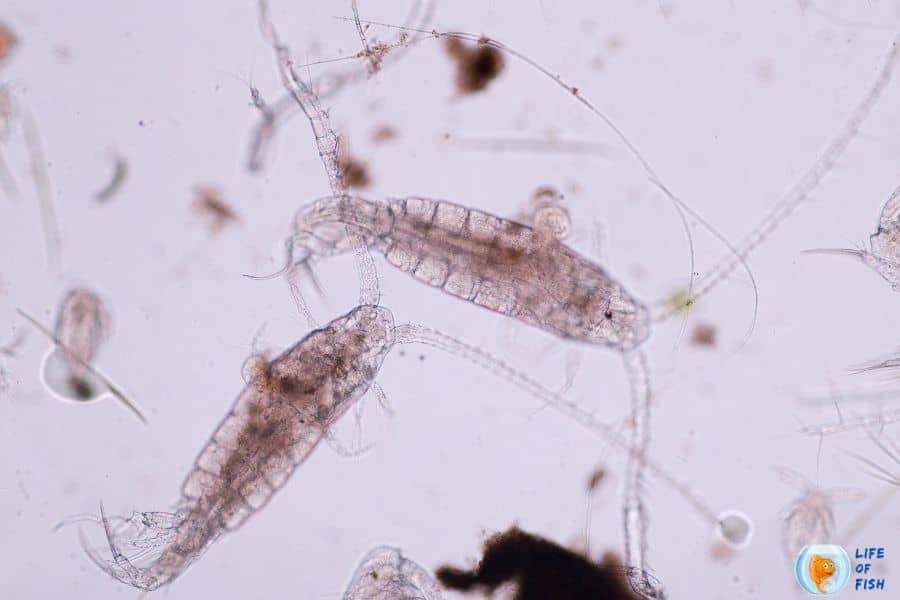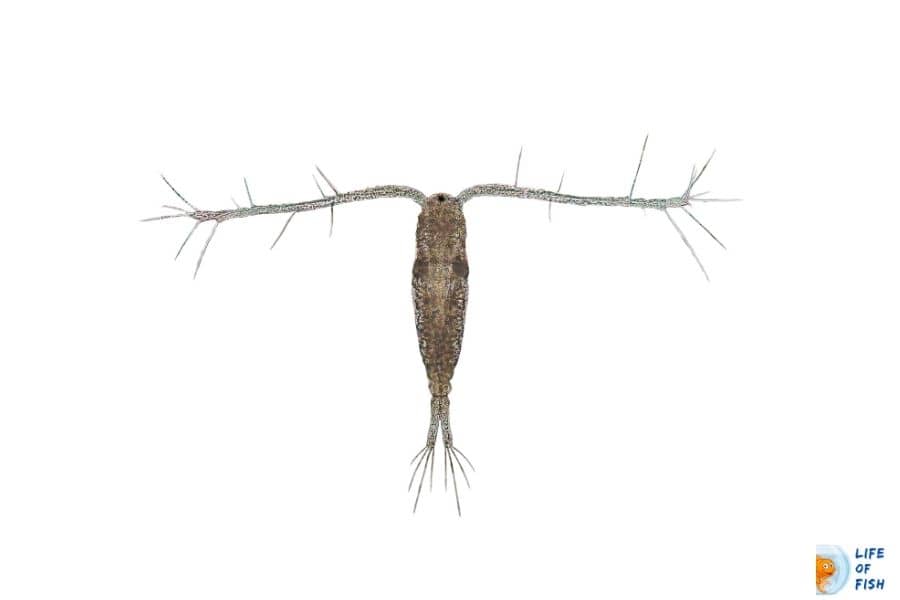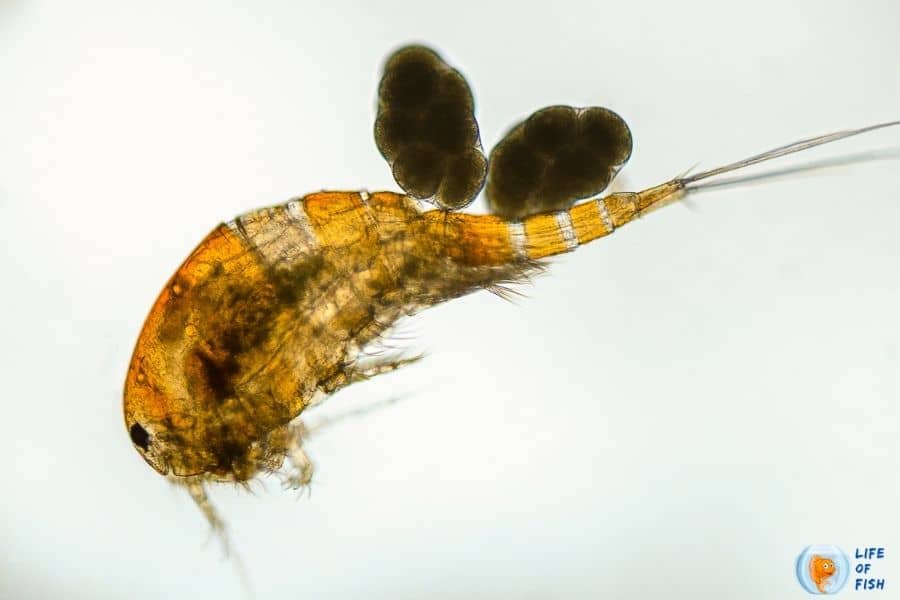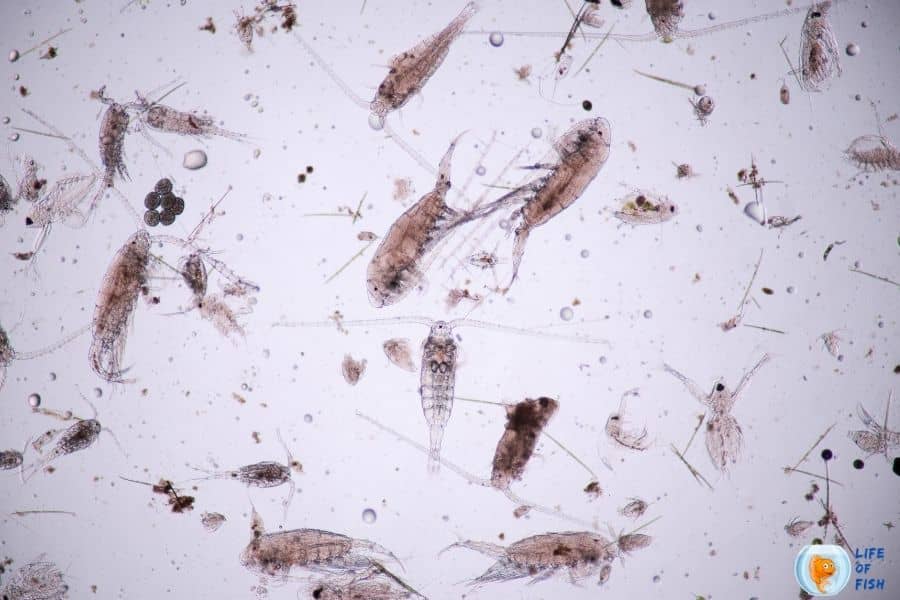Many aquarists think of copepods as pests while they are not. They are, in fact, beneficial for a healthy aquarium in several ways. Even some aquarists try to raise colonies of copepods in fish tank.
Getting rid of copepods is not as difficult as it seems to be. To get rid of copepods, feed your fish less, keep the aquarium clean and add some copepod predators.
Doesn’t explain much? Then keep reading this article.

What are copepods?
Jump To
- 1 What are copepods?
- 2 What do copepods look like?
- 3 How big do copepods get?
- 4 How quickly do copepods reproduce?
- 5 What do copepods eat?
- 6 How do copepods get in my tank?
- 7 Will copepods breed in my tank?
- 8 Are copepods bad for your tank?
- 9 How do I know if my tank has copepods?
- 10 How to get rid of copepods in a fish tank
- 11 How to get rid of copepods in a fresh water tank
- 12 How to get rid of copepods in a saltwater aquarium system
- 13 How to get rid of copepods in shrimp tank
- 14 Related Questions
- 15 Conclusion
Copepods are a group of crustaceans that live in both freshwater and saltwater habitats.
Some of these tiny organisms are pelagic (which means they live underwater), and some are benthic (which means they live on the ocean floor).
Copepods are found in nearly every water habitat, including swamps, bogs, springs, temporary ponds, puddles, and water-filled recesses of plants.
There are about 13000 known copepod species, of which 2800 of them live in freshwater. And they are important links in plankton food chain
What do copepods look like?
Copepods have a teardrop-shaped body and a large antenna. They are so small that most copepod species grow only up to 1 to 2 mm long.
However, some polar copepods reach about 1 cm. Most copepod species have a single median compound eye that is bright red in color and another pair of a small antennas.
But, these features are almost invisible to the naked eye because of their tiny size. The body is almost totally transparent.
Therefore, it is not easy to notice these creatures unless there is a copepod bloom in your aquarium.
How big do copepods get?
The average size of a copepod is about 1 to 2mm in length. However, some copepod species grow up to 1cm long.
How quickly do copepods reproduce?
Copepods take about 2 to 3 weeks to mature and produce about 300000 eggs throughout their reproductive period. Further, they live for about six months to one year.
What do copepods eat?
In the wild, these creatures eat phytoplankton (microscopic plants) . But in aquariums, copepods eat plant matter, decaying fish waste, and annoying algae such as diatoms.
So, as you see, they work as a group of cleaning staff in your aquarium.
Do copepods eat corals?
No. Copepods do not eat corals. However, it is done otherwise. Live corals consume tiny zooplankton such as copepods, brine shrimp, amphipods, and Mysis shrimps.
Copepods, as we said earlier, consume decaying matter of corals and algae on the corals.
Do copepods eat poop?
Yes. Copepods eat fish poop or, as we said earlier, detritus in the aquariums. So, as you see, they help clean your tank and reduce the Nitrate levels of your aquarium.
Do copepods eat plants?
Since these are tiny creatures, they can not consume large plants. Almost all copepod species are herbivores and eat phytoplankton (microscopic plants) for nutrition.
But, they are not capable of eating aquarium plants in any way. However, these creatures consume decaying matter of plants.
Do copepods eat fish?
Copepods are herbivores. They do not consume meat matters in any way. So, they do not eat saltwater fish or any other living creatures.
That means there is no threat to your aquarium life by copepods. Nonetheless, many saltwater fish love to eat copepods as they are good nutrition for them.
How do copepods get in my tank?
Copepods often make their way into your tank as hitchhikers, infesting live rocks, live sands, frags, and macro algae on their route to their new home.
However, some aquarium owners intentionally introduce these creatures to their aquariums (especially reef aquariums) by using certain products such as Pods & OceanMagik Phytoplankton by AlgaeBarn.
Will copepods breed in my tank?
Of course. When copepods receive plenty of food, they will multiply within a short period of time.
For one day, you will see a clean and clear tank, and the other day your tank will be full of copepods if you do not clean the tank often and overfeed your fish.
They get mature within three weeks, breed fast, and lay hundreds of thousands of eggs in their reproductive period.
When you overfeed your fish, they do not bother eating copepods in their surroundings as they are full.
And also, the leftover food will feed the copepods to grow well and breed.
So, even though you keep carnivore fish in your tank, copepods will have food and the freedom to reproduce as much as they can.
Are copepods bad for your tank?
Not at all. Most copepod types are herbivores and eat only phytoplankton, decaying plant matter, decaying fish waste, and annoying algae such as diatoms.
So, they do not pose a threat to your aquarium life in any way. They are actually beneficial for your aquarium as they eat benthic micro algae, scavenge detritus and serve as food for your fish.
The only problem is, copepod blooms make your aquarium less appealing.
Are copepods harmful to shrimp?
Copepods are entirely harmless to adult shrimps. That being said, they may pose a threat to the baby shrimps, especially if they are large copepods.
Although copepods are herbivores, they do not see a difference between detritus and shrimplets and fish fry.
So, if they get the chance to graze on these tiny creatures, they surely will.

How do I know if my tank has copepods?
If you can’t see any copepods in your aquarium and would like to know if there are any, we have a very simple test for you.
When sunsets, temporarily shut off your pump and lights. And then point a flashlight towards your aquarium.
If there are copepods in your aquarium, they will come towards the light as soon as possible.
Copepods are attracted to light, so they will find the light and go to it immediately when they get a chance.
How to get rid of copepods in a fish tank
So far, we have shared several reasons to keep copepods in your aquarium. But, from now on, you will find out the ways to get rid of copepods from your tank.

How to get rid of copepods in a fresh water tank
You can get rid of these hitchhikers in several ways. Below are some ways to remove copepods from your tank.
Keep the freshwater Aquariums Clean
Copepods get their nutrition from leftover food, detritus, and decaying matters.
When you clean up your aquarium often, you leave less food for these creatures to nurture.
Make sure you keep the aquarium clean by siphoning detritus and decaying matter at least once per week until the copepod population skims off.
Tip: Since copepods are attracted to light, you can use that to your advantage.
When you do the suction cleaning, turn off the lights and point a flashlight to one point in the aquarium.
When copepods gather around the light, simply siphon the water with the copepods.
Do not overfeed your fish
The main reason for copepods blooms is overfeeding your fish.
When you feed your fish more than they require, the leftovers go to the bottom and decay, which gives more food for copepods.
Copepods tend to reproduce more when they receive plenty of food, and in the end, you will end up with a cloud of copepods in your aquarium.
To fix this, simply cut off some feedings or reduce the feeding amount for your fish.
Add copepod predators
If you don’t have any carnivore fish in your aquarium, consider adding some suitable fish to it so that they will take care of your copepod problem.
Here are some freshwater fish that eat copepods.
However, you may not be able to introduce these species in a shrimp tank, as any fish that eat copepods are known to eat shrimps.
- Honey Gourami
- Endlers
- Celestial Pearl Danios
- Ruby Tetras
- Betta
- Rasboras
- Cardinal Tetras
- Pygmy Corys
- Hatchet Fish
- Harlequin Rasboras
- Ember Tetras
- Neon Tetras
- Gold Ring Danios
- Microdevario Kubotai
Change the Filter
Sometimes, if the filter doesn’t work as expected, most fish waste will stay on the bottom of the tank and decay, leaving sufficient food for copepods.
As these creatures eat this waste, you may not notice any water quality change in water.
But, within about two weeks, you will find hundreds of thousands of these critters in your tank.
So, if you are feeding less and perform water changes weekly and still see copepods in your aquarium, it is time to change or fix the filter.
Bleach everything in the tank, including the tank
If you’ve got a bad infestation of copepods and doing everything above doesn’t work. It is time to step onto the last step.
But, keep in mind that doing this may also harm your fish, plants and beneficial bacteria inside the tank. So, you should follow all the steps below to be safe.
- Remove your fish from the tank and keep them in a temporary tank
- Fully drain the tank and wash everything with a bleach mixer, and then water.
- You should bleach substrate, decorations, plants, filter, water pump and any other equipment in your tank.
- You should also bleach the tank itself. Keep them aside for about an hour. (Tip: Separating each equipment, decoration, plants, and substrate and bleaching them one by one will make things easier when putting them back to the tank)
- Now, put everything back into the tank and fill the tank with water. But, do not put your fish yet.
- Fully cycle the tank for about two weeks.
- In the meantime, you should cut off some feedings of your fish in the temporary tank.
- When you transfer your fish, copepods may also be transferred to the temporary tank with your fish.
- So, feeding less will cease the food supply for copepods and will die ( or your fish will eat them) during this time.
- After about two weeks, check the water condition of your tank.
- If everything seems normal, you can replace your fish to the tank. (Tip: To be extra safe, first add some hardy fish to the tank and observe them for about 2 to 3 days. If they are doing fine, reintroduce your other fish to the tank.)

How to get rid of copepods in a saltwater aquarium system
Saltwater Copepods populations in a reef aquarium are really beneficial for its life, especially for the live corals.
Copepods help cleaning corals and serve as food to live corals and fish. Therefore, many saltwater aquarists culture saltwater copepods in their aquariums.
But, if you insist on removing these creatures from your reef tank follow below steps.
Keep the saltwater aquarium environment clean
Cleaning the aquarium often will remove any excess food, decaying matter, and fish waste, which removes food sources of copepods.
So, when they starve, their populations eventually fade away. We recommend at least one water siphoning clean weekly until copepods go away.
Tip: Since copepods are attracted to light, you can use that to your advantage.
When you do the suction cleaning, turn off the lights and point a flashlight to one point in the aquarium.
When copepods gather around the light, simply siphon the water with the copepods.
Do not overfeed your saltwater fish
When you overfeed your fish, the excess food goes to the bottom, leaving more food for copepods.
Simply cutting off some food will eliminate copepod population eventually.
This may not be a faster solution to get rid of copepods, but it can efficiently reduce copepods population with a combination of other steps.
Introduce copepod predators
Getting rid of copepods in a saltwater aquarium is much easier than in a freshwater aquarium because some saltwater predators love eating copepods.
For example, mandarins will only eat live copepods and die starving when the copepod population ends (and it will be sooner as mandarins have an insatiable appetite).
So, if you keep a mandarin in your aquarium, you will have to culture copepods in another tank if you want this magnificent fish to live longer.
Apart from fish shrimp-like other marine species also prefer to eat copepod due to their
Some other copepods eating fish are,
- Wrasse
- Copper band Butterflies
- Clown fish
- Halichoeres Genus Wrasses
- Chrysiptera Genus Damsels
- Possum Wrasse
- Scooter Blennies
How to get rid of copepods in shrimp tank
Getting rid of copepods in a shrimp tank is more complicated than a fish-only tank or saltwater tank.
Usually, predators that eat copepods also eat shrimps. So, you can not add carnivore fish species to get rid of copepods.
And also, shrimps are highly sensitive to water changes, so you can’t add any chemicals to kill copepods.
However, you can control the copepod population in shrimp tanks if you follow the steps below.
Maintain a Clean Aquarium
Copepods survive on leftover food, debris, and decomposing stuff.
When you clean your aquarium on a regular basis, you leave less food for these creatures to feed on.
Keep the aquarium clean by siphoning off trash and rotting matter at least once a week until the copepod population has vanished.
Tip: Because copepods are attracted to light, you can take advantage of this. Turn off the lights and shine a flashlight at one location in the tank while suction cleaning.
Simply siphon the water with the copepods as they gather around the light.
Avoid overfeeding your shrimp.
Overfeeding your shrimps is the primary cause of copepod blooms.
When you feed your shrimps more than they need, the leftovers sink and rot, providing extra food for copepods.
Copepods tend to multiply more when there is lots of food available, resulting in a cloud of copepods in your aquarium.
Simply discontinue some feedings or lessen the amount of food your fish receives to correct this.
Change the filter
If you feed less and perform water changes regularly, but copepods population increases day by day, it might be a problem with your filtration system.
Change the filter to a more powerful one or repair it if it doesn’t work properly.

Related Questions
What fish will eat copepods?
Usually, carnivore fish species that eat zooplankton, shrimps, and worms graze on copepods. Copepods are primary food source of some saltwater fish.
Some copepod eating freshwater fish species are,
- Honey Gourami
- Endlers
- Celestial Pearl Danios
- Ruby Tetras
- Betta
- Rasboras
- Cardinal Tetras
- Pygmy Corys
- Hatchet Fish
- Harlequin Rasboras
- Ember Tetras
- Neon Tetras
- Gold Ring Danios
- Microdevario Kubotai
Some copepod eating saltwater fish species are,
- Mandarin
- Wrasse
- Copperband Butterflies
- Clownfish
- Halichoeres Genus Wrasses
- Chrysiptera Genus Damsels
- Possum Wrasse
- Scooter Blennies
Do clownfish eat copepods?
Yes. Clownfish eat copepods. However, they do not eliminate these pests like mandarins because they are not voracious eaters.
Clownfish, on the other hand, will help you in keeping the copepod population low.
Do Corals eat copepods?
Yes. Live corals eat copepods. Copepods also benefit the corals by cleaning the decaying matter stuck on corals.
Do snails eat copepods?
No. We’ve never heard of snails eating copepods, maybe because snails are, you know, slow, and copepods aren’t.
Does live sand have copepods?
Yes. Live sand contains microscopic biological bacteria along with many tiny crustaceans and other micro and macro-organisms like copepods, bristle worms, tiny starfish, and amphipods.
In saltwater aquariums, live sand serves as the main base for biological filtration and provides food for aquarium life through its small living creatures.
Conclusion
Copepods can be pests if blooms happen in the aquariums. Otherwise, a small population of copepods indicates a healthy aquarium for your fish.
They work as cleaning staff and serves as food for your fish.
Keeping them under control is beneficial but, when things go wrong, you can get rid of copepods in the fish tank by following the above steps.
Read Next: Are Coconut Crabs Dangerous? | 17 Mind Numbing Facts |
